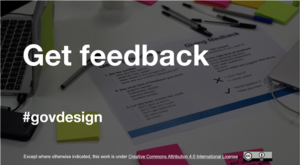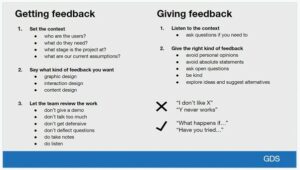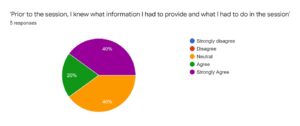We’ve been thinking a lot about how to give feedback to each other in the team. The way things are structured, you might not work with every discipline on every project. But it’s helpful to get different perspectives, outside of the team working on the project.
Taking inspiration from GDS
Government Digital Service (GDS) run feedback sessions every Wednesday. These are well structured and are worth attending, either as a feedback giver or receiver. They kindly publish their 'Get Feedback Slides' as open source, so that you can use them in your own sessions.
Trying it out at Essex
So, we started using these sessions at Essex. I started by chucking some time in the calendar and using the GDS slides word for word. Initially, I put some of my own work up for feedback to help show that it was nothing to be scared of. Some brave volunteers were quick to come forward and present some work.

I feed your back, you feed mine?
By way of some teams messaging with participants after their session, I got some initial feedback and tweaked the slides to suit people’s needs at Essex. There were some positive reactions from the guinea pigs:
Really good - I've got some good ideas of things I should probably improve now, and some things to think about for a future iteration.
Overall it was great and I came away with some things I'll definitely try.
As well as some useful insights on how the session could be improved for them:
As a person receiving feedback I think I want to look at that powerpoint a bit longer, in terms of receiving feedback. Could be handy to receive that ahead of time to prep for not being defensive.
Reducing the facilitation needed up front. Fewer slides would be better. two slides with just the key bits would work great for me.
Was feeling there was a bit of production blocking in today's session.
In terms of reducing the slides up front, this was fairly simple to implement. It also made more sense for our context. At the GDS sessions it’s more likely that you’ll be with a group of people that you’ve not met before. In our sessions it was often a similar group of people, who all knew each other well and worked together.
So, we needed less focus on the initial icebreakers, and more focus on the ‘need to know’ pieces of information.
The most important slide for our uses seems to be this super helpful breakdown of how to give and receive feedback.

It’s useful that it gives tips for both sides, with a focus on not having to defend design decisions and trying to avoid absolute statements and personal opinions. Open questions and coming up with ideas and solutions are the order of the day.
Feedback can sound daunting and punitive, but in this format should be energising, positive and constructive. I think the definition of success for these meetings is that the person receiving feedback comes away feeling enthusiastic, with a load of potential ideas they can choose to explore as they wish.
Getting the word out
I found that there was some appetite for these sessions, with 4 or 5 people who would attend each time and get involved. To try to get a broader range of disciplines involved, I ran through what a Get Feedback session entails at a show and tell. My assumption is that for some it might seem daunting to bring work for feedback. I wanted to show that these sessions are, dare I say it, fun?
Our survey says…
To test out whether the sessions were working as best as possible, for feedback givers and receivers. A couple of areas to address came out of this.
Things people liked:
Diverse range of specialisms and viewpoints.
Getting different perspectives helped to improve my work.
Multiple different areas of expertise feedback can be sought at one forum.
Things people wanted to change:
Some areas not as well-represented as others.
Maybe having a representative from each area at meeting?
Not always obvious of the best things to give feedback on, usually when it was a broad topic or the context wasn't fully understood beforehand.
Might be helpful to have the instructions you provide at the start of the session prior to it, maybe in the pack with the feedback template.
People were a little less confident in terms of having enough information prior to the session:
Next up
In the next round of sessions, I want to test out some changes based on these survey responses. We can trial:
- Having a representative from each discipline signed up, for example one user research, one content, one service design, a product manager, on business design practitioner.
- Giving more support to the feedback giver in advance when shaping their ask for feedback, making sure the scope is narrow enough for people to give actionable suggestions.
- Providing more information before the session, for example supplying a slide of ‘good feedback tips’ for people to have as a reference.

Leave a comment